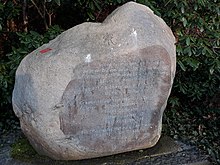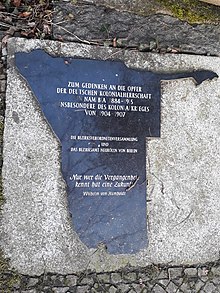Herero Stone
The Hererostein (also Afrikastein ) is a memorial stone on the Columbiadamm cemetery in Berlin-Neukölln . It is dedicated to seven volunteers of the German protection force who fell between 1904 and 1907 in what was then the colony of German South West Africa . After protests by civil society associations against this commemoration of the perpetrators of a genocide , a memorial plaque was laid in the ground in front of the stone in 2009, reminding of the victims among the Herero and Nama peoples . The ensemble of Hererostein and Namibia commemorative plaque is the only monument in Berlin that commemorates the former German occupation of Namibia .
description
Herero Stone
The boulder made of reddish granite has a smooth surface on the front with the following inscription:
Of the 41 members of the regiment who
voluntarily took part in the campaign in South-West Africa
from January 1904 to March 1907
, the heroic death of
Lieutenant Richard von Rosenberg
Bodo von Ditfurth
Grenadier Johann Hovel 1 Comp.
Fusilier Johann Orphel 10 "
Franz Dallmann 12"
Johann Fausser 12 "
Karl Kliebisch 12"
The officer corps honors
the memory of the heroes with this stone .
Above the inscription is the sign of the Kaiser-Franz-Garde-Grenadier-Regiment No. 2 , whose officers donated the stone in 1907.
Today the boulder bears the emblem of the Verband Deutsches Afrika-Korps e. V. - a palm tree in the red coat of arms with the iron cross and the words "AFRIKA 1941 1943". On the right is the emblem of the traditional association of former protection and overseas troops - the stylized protection troop hat , a floppy hat with a cockade in the colors of the German imperial flag .
Namibia commemorative plaque
On the floor to the left in front of the Herero stone is a polished black stone slab with the outlines of today's state of Namibia. It bears the inscription:
IN MEMORY OF THE VICTIMS
OF THE GERMAN COLONIAL RULE
IN NAMIBIA 1884-1915
PARTICULAR COLONIAL WAR
OF 1904-1907
THE Borough Assembly
AND
THE DISTRICT OFFICE OF BERLIN NEUKÖLLN
Only those who the past
knows has a future
Wilhelm von Humboldt
Historical background
German South West Africa was a German colony from 1884 to 1915 in what is now the state of Namibia. In 1904 the Herero pastoral people rose against the colonial power. Under the command of Lieutenant General von Trothas , the German protection force did not only act with ruthless severity against armed fighters. After the decisive battle at Waterberg on August 11, 1904, the Schutztruppe executed every male member of the defeated Herero that was found. Tens of thousands of people who had fled to the Omaheke sand field died of thirst at the end of 1904 because the protection force denied them access to the few water points. Surviving Herero and members of the Nama, who had also rebelled in the meantime, were interned in concentration camps where they had to do heavy labor. The death rate there was around 50%. The actions of the protection force are now classified as the first genocide of the 20th century. 50 to 75% of the Herero and half of the Nama, a total of around 40,000 to 70,000 people, fell victim to it. The German casualties amounted to 676 fallen and 76 missing soldiers, as well as 689 deaths from illness.
History of the Herero stone
The memorial stone was erected in 1907 on what was then the barracks area of the Kaiser-Franz-Garde-Grenadier-Regiment No. 2 in Urbanstraße . In 1973 it was restored on the initiative of the Afrika-Kameradschaft Berlin and the traditional association of former protection and overseas troops, provided with their emblems and moved to Columbiadamm . In addition, a small stone was placed in front of him, which with its inscription "To honor the German soldiers who fell in Africa" included the German soldiers who died in Africa in the First and Second World Wars . Since then the stone is also called Africa stone. Since similar monuments, such as the obelisk erected in 1908 for the fallen members of the 1st Telegraph Battalion and a stone for the dead of the Railway Regiment No. 2 from 1910, have not been preserved, the Hererostein was the last remaining monument. which in Berlin reminded of the German occupation of Namibia. Veterans' associations and right-wing extremist groups regularly lay wreaths here.
The fact that the Herero stone honored the dead of the perpetrators, but that there was no place of remembrance in Berlin for the victims under the Herero and Nama, led to ongoing protests by various civil associations. To mark the 100th anniversary of the Battle of Waterberg in 2004, the sponsoring group unveiled “Remembering - Working Up German Colonial History”, an amalgamation of the Berlin Development Policy Council. V. (BER), the parliamentary group of Bündnis 90 / Die Grünen in the Berlin House of Representatives and the Solidarity Service International e. V. (SODI) on the Hererostein a provisional plaque with the inscription "In memory of the victims of the German genocide in Namibia 1904-1908". Speakers were the member of the Bundestag from Bündnis 90 / Die Grünen, Hans-Christian Ströbele , the chairman of the Berlin Education and Science Union , Ulrich Thöne , and Johannes Schöche from SODI. The plaque disappeared after a few days, and in 2005 the memorial stone for the soldiers of the world wars.
In 2004 the district councilor Marcus Albrecht ( SPD ) submitted an application to the district council assembly in Neukölln for the erection of a memorial plaque for the victims of the genocide, which was accepted against the votes of the CDU and the FDP . Its implementation was delayed, however, mainly due to disputes over the text, with the exact number of victims and the valuation as genocide in particular being disputed. It was not until October 2, 2009 - the 105th anniversary of the extermination order of Lieutenant General von Trothas - was the memorial plaque unveiled by the Namibian Ambassador to Germany, Neville Gertze , in the presence of the District Mayor of Neukölln, Heinz Buschkowsky .
Representatives of civil society groups, who were not allowed to speak at the inauguration, criticized the text of the memorial plaque in a joint press release on September 23, 2009 . The fact that there is only talk of “colonial war” is a trivialization of genocide. The then Neukölln City Councilor Thomas Blesing (SPD), on the other hand, referred to the taz on the broad voting process in the debate about the memorial plaque. “The text was agreed with the Foreign Office , the Namibian Embassy , the Senate Chancellery and the Neukölln District Assembly. In the discussion about the inscription, the Federal Foreign Office 'strongly advised against' using the term genocide. "
Documentary film
- German South What? Memory of a German genocide . Film group E, 2013
Web links
Individual evidence
- ↑ a b Johannes Wendt : The Africa stone: Dusty memory of German colonial times in Namibia . Development Policy Online (epo), June 28, 2008, accessed on September 13, 2018.
- ↑ George Steinmetz : From the "indigenous policy" to the extermination strategy: German South West Africa, 1904. In: Periphery: Journal for politics and economics in the third world . Volume 97–98, Vol. 25, 2005, pp. 195–227, here: p. 195 ( full text in Open Access ).
- ^ Isabel V. Hull: Absolute Destruction: Military Culture and the Practices of War in Imperial Germany . Cornell University Press, New York 2005, ISBN 0-8014-4258-3 , pp. 88 (English, limited preview in Google Book Search).
- ↑ Andreas Conrad: A black chapter . Der Tagesspiegel on January 10, 2004, accessed on September 14, 2018.
- ↑ Christiane Habermalz: Colonial Not commemoration in Germany . Deutschlandfunk on February 16, 2018.
- ↑ a b Joachim Zeller : Report on the Berlin memorial event for the Waterbergschlacht 1904 (2004) on the website www.freiburg-postkolonial.de, accessed on September 14, 2018.
- ↑ Thea Fleischhauer: Gedächtnisgeschichte Tempelhofer Feld: Former garrison cemetery on Columbiadamm on the Tempelhofer Unfreedom website, accessed on September 15, 2018.
- ↑ Speech by the Namibian Ambassador Neville Gertze on the occasion of the unveiling of the memorial stone in honor of the victims of German colonial rule in Namibia (PDF; 49 kB) on October 2, 2009 at the garrison cemetery in Neukölln, Berlin, Columbiadamm 122-124, accessed on May 18, 2009. September 2018 (English).
- ↑ Armin Massing: Downplaying genocide - Neukölln is planning a memorial stone that is not suitable for reconciliation with Namibia . Joint press release by Africa Council , Berlin Development Policy Council (BER), Berlin Postkolonial, Initiative Schwarze Menschen in Deutschland (ISD Bund), p.art.ners berlin-windhoek, Solidarity Service International (SODI) and Workshop of Cultures , 23 September 2019, accessed September 20, 2018.
- ↑ Alexandra Kunze: The stumbling block . taz on September 29, 2009, accessed on September 20, 2018.
Coordinates: 52 ° 28 ′ 50 " N , 13 ° 24 ′ 47.2" E





